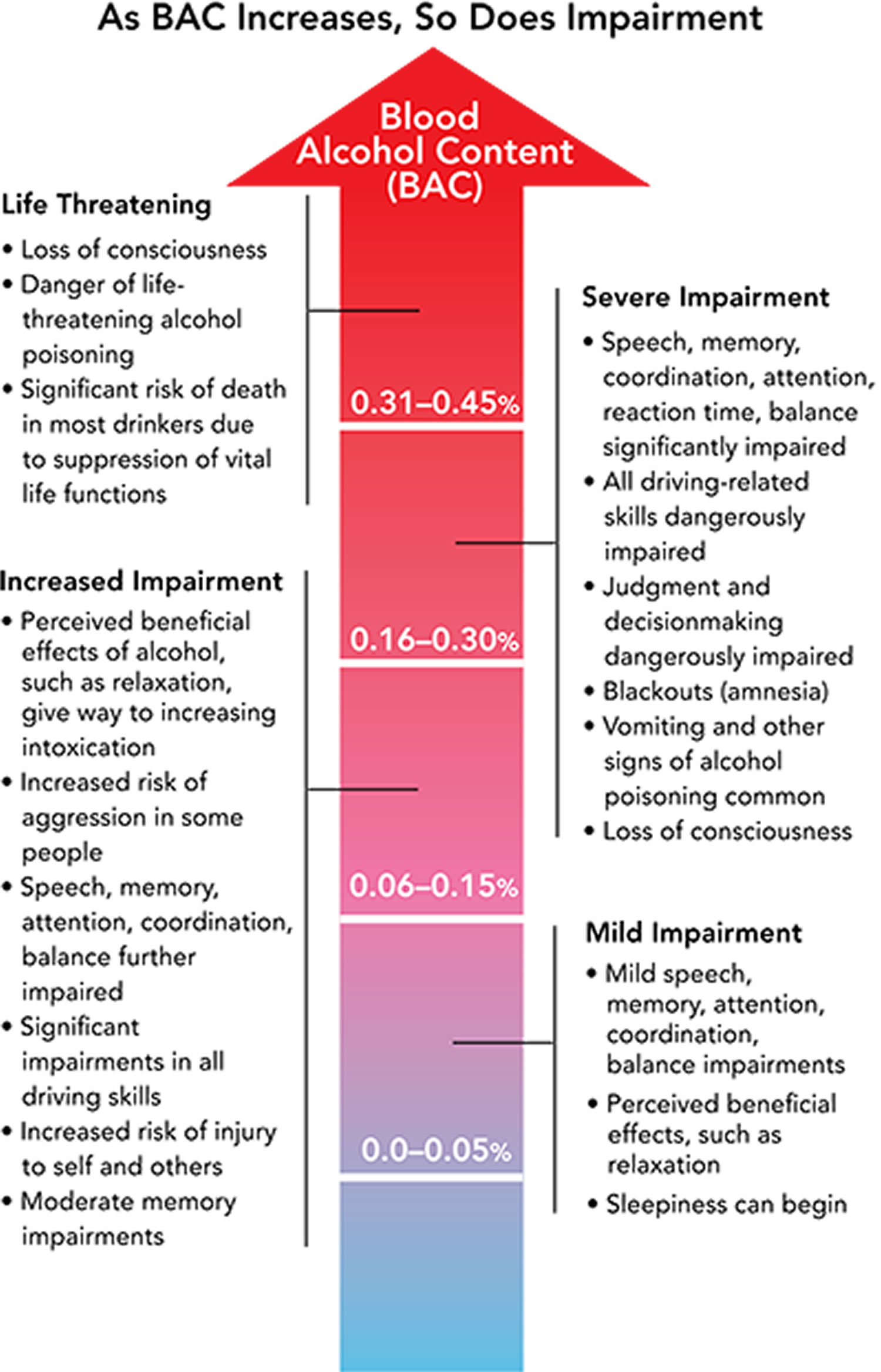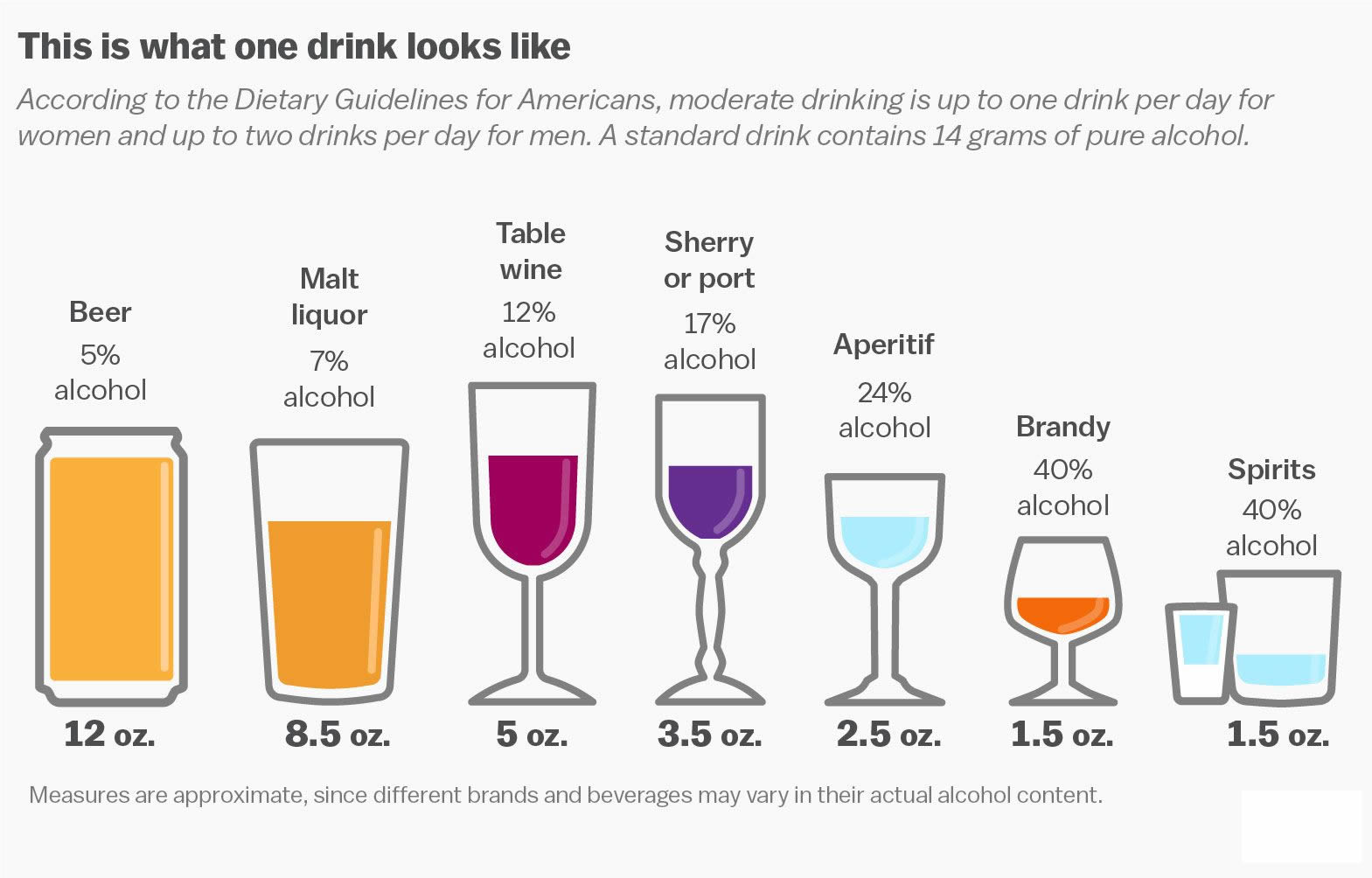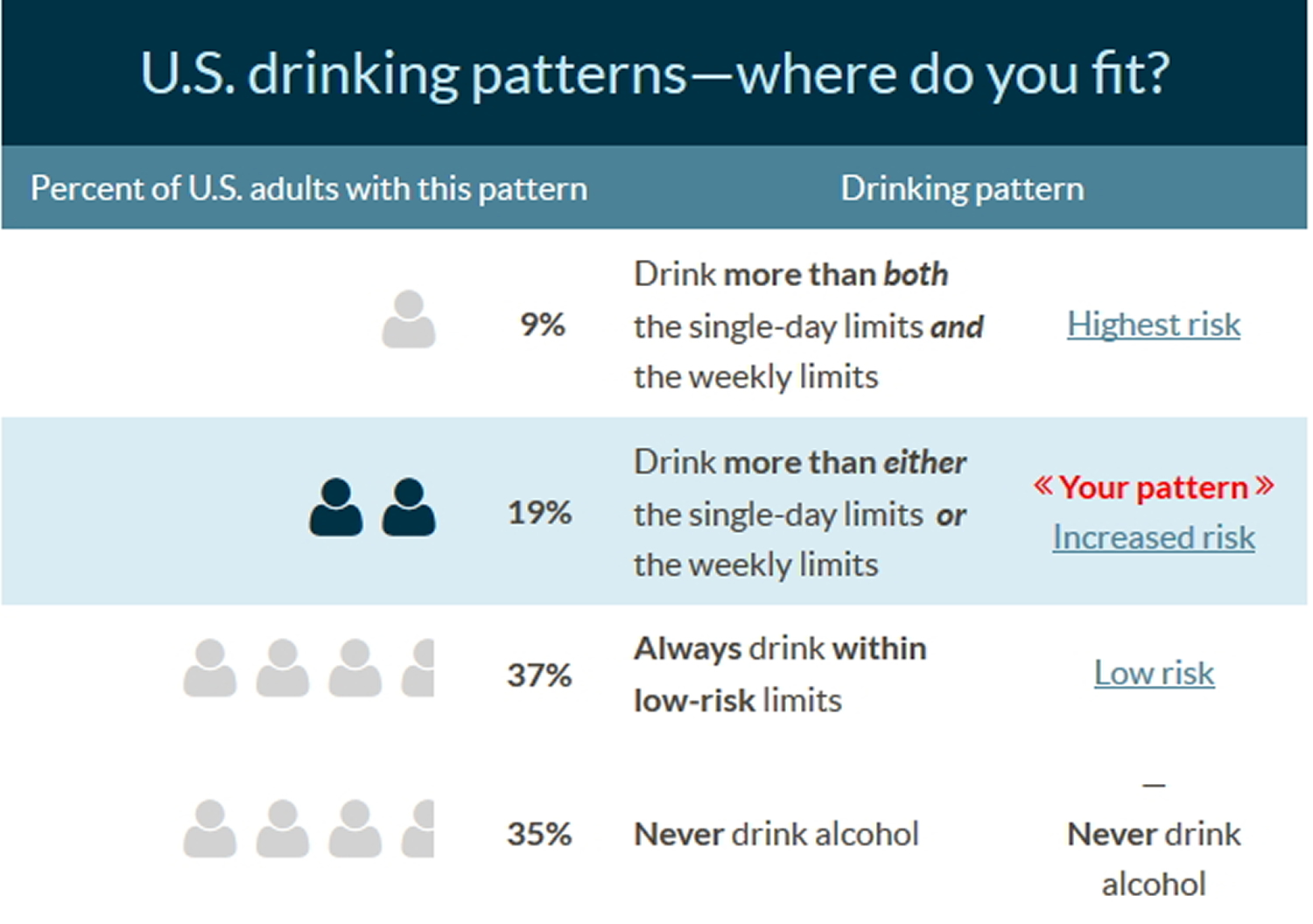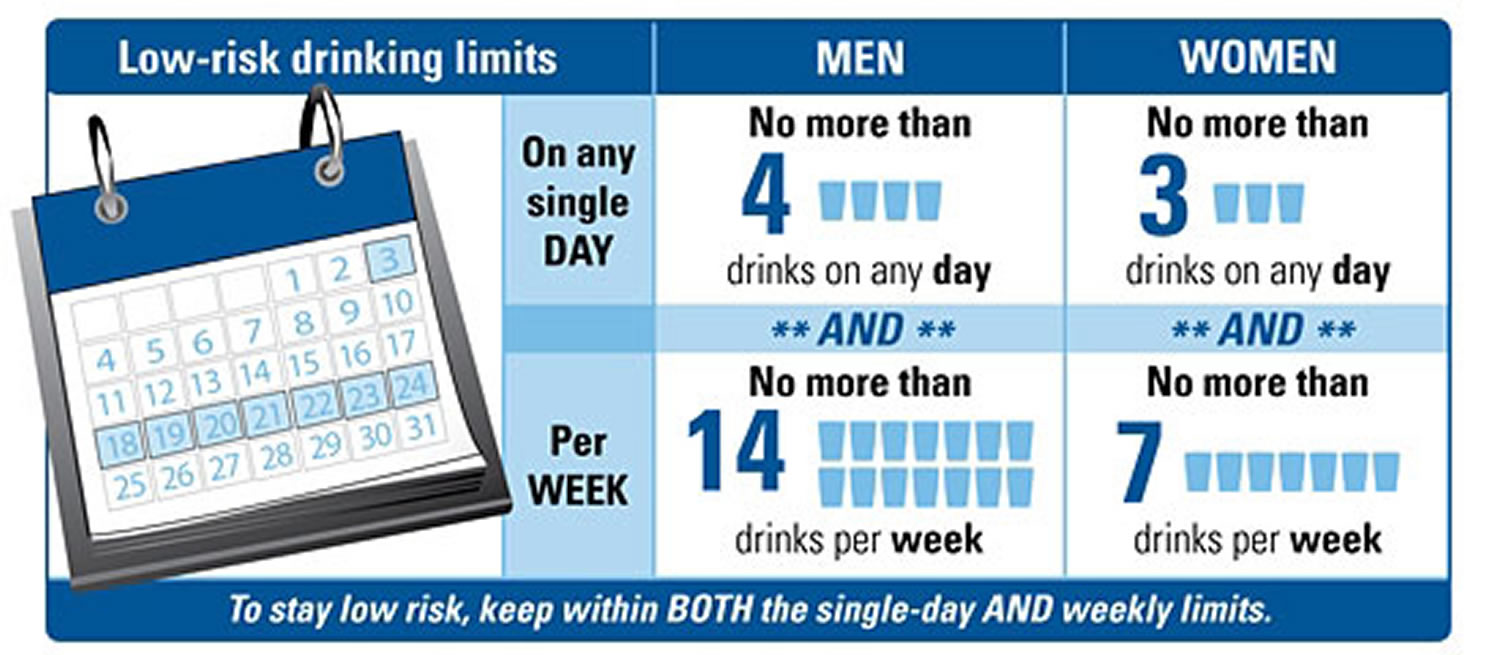Contents
- What is alcohol poisoning
- Alcohol related deaths
- Figure 2. Alcohol Poisoning Deaths
- What counts as a standard drink ?
- How much is too much ?
- Risk factors for alcohol poisoning
- Signs and symptoms of alcohol poisoning
- Severe complications can result from alcohol poisoning, include:
- Alcohol poisoning treatment
- How long does alcohol poisoning last
What is alcohol poisoning
Alcohol in the form of ethanol (ethyl alcohol) is found in alcoholic beverages, mouthwash, cooking extracts, some medications and certain household products. Alcohol (ethanol) poisoning also known as alcohol overdose is generally caused by binge drinking at high intensity or from drinking too many alcoholic beverages, especially in a short period of time. Such drinking can exceed the body’s physiologic capacity to process alcohol, causing the blood alcohol concentration to rise. Alcohol exerts its effects by several mechanisms. Alcohol binds directly to gamma-aminobutyric acid (GABA) receptors in the brain, causing sedation. Alcohol also directly affects cardiac, hepatic, and thyroid tissue. Very high levels of alcohol in the body can shutdown critical areas of the brain that control breathing, heart rate, and body temperature, resulting in death. Alcohol poisoning deaths affect people of all ages but are most common among middle-aged adults and men. The clinical signs and symptoms of an overdose of alcohol occurs when a person has a blood alcohol content sufficient to produce impairments that increase the risk of harm.
- Rapid binge drinking (which often happens on a bet or a dare) is especially dangerous because the victim can drink a fatal dose before losing consciousness.
Alcohol overdoses can range in severity, from minimal impairment with balance, decreased judgment and control, slurred speech, reduced muscle coordination, vomiting, and stupor (reduced level of consciousness and cognitive function) to coma and death 1. However, an individual’s response to alcohol is variable depending on many factors, including the amount and rate of alcohol consumption, health status, consumption of other drugs, age, gender, the amount of food eaten, even ethnicity and metabolic and functional tolerance of the drinker 2, 3.
Other forms of alcohol — including isopropyl alcohol (found in rubbing alcohol, lotions and some cleaning products) and methanol or ethylene glycol (a common ingredient in antifreeze, paints and solvents) — can cause other types of toxic poisoning that require emergency treatment.
A major cause of alcohol poisoning is binge drinking — a pattern of heavy drinking when a male rapidly consumes five or more alcoholic drinks within two hours, or a female downs at least four drinks within two hours. An alcohol binge can occur over hours or last up to several days.
You can consume a fatal dose before you pass out. Even when you’re unconscious or you’ve stopped drinking, alcohol continues to be released from your stomach and intestines into your bloodstream, and the level of alcohol in your body continues to rise.
- If you suspect someone has alcohol poisoning, get medical help immediately. If you or someone you are with has an exposure, call your local emergency number (such as 911) immediately. Cold showers, hot coffee, or walking will not reverse the effects of alcohol overdose and could actually make things worse.
- When in doubt, call for medical help.
- If you are having difficulty in determining whether an individual is acutely intoxicated, contact a health professional immediately – you cannot afford to guess.
- Hundreds of people die each year from acute alcohol intoxication, more commonly known as alcohol poisoning or alcohol overdose. Caused by drinking too much alcohol too fast, it often occurs on college campuses or wherever heavy drinking takes place.
- At the hospital, medical staff will manage any breathing problems, administer fluids to combat dehydration and low blood sugar, and flush the drinker’s stomach to help clear the body of toxins.
- The best way to avoid an alcohol overdose is to drink responsibly if you choose to drink.
Figure 1. Alcohol Poisoning Scale
[Source 4]Alcohol is absorbed into the blood mainly from the small bowel, although some is absorbed from the stomach. Alcohol accumulates in blood because absorption is more rapid than oxidation and elimination. The concentration peaks about 30 to 90 min after ingestion if the stomach was previously empty 5.
About 5 to 10% of ingested alcohol is excreted unchanged in urine, sweat, and expired air; the remainder is metabolized mainly by the liver, where alcohol dehydrogenase converts ethanol to acetaldehyde. Acetaldehyde is ultimately oxidized to CO2 and water at a rate of 5 to 10 mL/hour (of absolute alcohol); each milliliter yields about 7 kcal. Alcohol dehydrogenase in the gastric mucosa accounts for some metabolism; much less gastric metabolism occurs in women.
In alcohol-naive people, a blood alcohol level of 300 to 400 mg/dL (BAC 0.3 to 0.4 percent) often causes unconsciousness, and a BAC ≥ 400 mg/dL may be fatal. Sudden death due to respiratory depression or arrhythmias may occur, especially when large quantities are drunk rapidly. This problem is emerging in US colleges but has been known in other countries where it is more common. Other common effects include hypotension and hypoglycemia.
The effect of a particular BAC varies widely; some chronic drinkers seem unaffected and appear to function normally with a BAC in the 300 to 400 mg/dL range, whereas nondrinkers and social drinkers are impaired at a BAC that is inconsequential in chronic drinkers.
An average of 6 people die of alcohol poisoning each day in the US from 2010 to 2012 6.
76% of alcohol poisoning deaths are among adults ages 35 to 64 6.
About 76% of those who die from alcohol poisoning are men 6.
Alcohol poisoning deaths:
- Most people who die are 35-64 years old.
- Most people who die are men.
- Most alcohol poisoning deaths are among non- Hispanic whites. Although a smaller share of the US population, American Indians/Alaska Natives have the most alcohol poisoning deaths per million people of any of the races.
- Alaska has the most alcohol poisoning deaths per million people, while Alabama has the least.
- Alcohol dependence (alcoholism) was identified as a factor in 30% of alcohol poisoning deaths.
Binge drinking can lead to death from alcohol poisoning.
- Binge drinking (4 or more drinks for women or 5 or more drinks for men in a short period of time) typically leads to a blood alcohol concentration (BAC) that exceeds 0.08 g/dL, the legal limit for driving in all states.
- US adults who binge drink consume an average of about 8 drinks per binge, which can result in even higher levels of alcohol in the body.
- The more you drink the greater your risk of death.
An estimated 88,000 people (approximately 62,000 men and 26,000 women) die from alcohol-related causes annually, making alcohol the fourth leading preventable cause of death in the United States 7. Alcohol deaths accounted for 1 in 10 deaths among working-age adults aged 20–64 years 8. Excessive alcohol use shortened the lives of those who died by about 30 years. These deaths were due to health effects from drinking too much over time, such as breast cancer, liver disease, and heart disease, and health effects from consuming a large amount of alcohol in a short period of time, such as violence, alcohol poisoning, and motor vehicle crashes.
In 2014, alcohol-impaired driving fatalities accounted for 9,967 deaths (31 percent of overall driving fatalities) 9.
Figure 2. Alcohol Poisoning Deaths
[Source: Centers for Disease Control and Prevention 6]What counts as a standard drink ?
Many people are surprised to learn what counts as a drink. In the United States, a “standard” drink is any drink that contains about 0.6 fluid ounces or 14 grams of “pure” alcohol. Although the drinks pictured here are different sizes, each contains approximately the same amount of alcohol and counts as a single standard drink.
Note: The percent of “pure” alcohol, expressed here as alcohol by volume (alc/vol), varies by beverage.
The examples above serve as a starting point for comparison. For different types of beer, wine, or malt liquor, the alcohol content can vary greatly. Some differences are smaller than you might expect, however. Many light beers, for example, have almost as much alcohol as regular beer—about 85% as much, or 4.2% versus 5.0% alcohol by volume (alc/vol), on average 10.
One drink is defined as:
- 12 fluid ounces (355 milliliters) of regular beer (about 5 percent alcohol)
- 8 to 9 fluid ounces (237 to 266 milliliters) of malt liquor (about 7 percent alcohol)
- 5 fluid ounces (148 milliliters) of wine (about 12 percent alcohol)
- 1.5 fluid ounces (44 milliliters) of 80-proof hard liquor (about 40 percent alcohol)
Mixed drinks may contain more than one serving of alcohol and take even longer to metabolize.
If you want to know the alcohol content of a canned or bottled beverage, start by checking the label. Not all beverages are required to list the alcohol content, so you may need to search online for a reliable source of information, such as the bottler’s Web site. For fact sheets about how to read wine, malt beverage, and distilled spirits labels, visit the consumer corner of the U.S. Alcohol and Tobacco Tax and Trade Bureau 11.
Although the “standard” drink amounts are helpful for following health guidelines, they may not reflect customary serving sizes. In addition, while the alcohol concentrations listed are “typical,” there is considerable variability in alcohol content within each type of beverage (e.g., beer, wine, distilled spirits). If you want to know how much alcohol is in a cocktail or a beverage container, try the U.S. Department of Health and Human Services. Rethinking Drinking – Alcohol calculators 12 or go here https://www.rethinkingdrinking.niaaa.nih.gov/Tools/Calculators/Default.aspx.
How much is too much ?
Unlike food, which can take hours to digest, alcohol is absorbed quickly by your body — long before most other nutrients. And it takes a lot more time for your body to get rid of the alcohol you’ve consumed. Most alcohol is processed (metabolized) by your liver.
The more you drink, especially in a short period of time, the greater your risk of alcohol poisoning.
The Dietary Guidelines for Americans defines moderate drinking as up to 1 drink per day for women and up to 2 drinks per day for men 13. In addition, the Dietary Guidelines do not recommend that individuals who do not drink alcohol start drinking for any reason.
You are drinking too much if:
- On any day in the past year, For MEN: you drink more than 4 “standard” drinks per day and For WOMEN: you drink more than 3 “standard” drinks per day.
- On average, you drink alcohol more than 2 days per week.
- On a typical drinking day, you drink more than 4 standard drinks (for Men) or more than 3 standard drinks (for Women).
Figure 3. U.S. Adults Drinking Patterns
[Source: U.S. Department of Health and Human Services. Rethinking Drinking 14]You have had more “heavy drinking days” in the past year than 7 in 10 U.S. adults . Although your weekly average is typically within low-risk limits, once or twice a week you have more than the single-day limit of 4 drinks for men. You may be surprised that the majority of U.S. adults never exceed the low-risk drinking limits.
Your particular risk depends on how much, how quickly, and how often you drink. According to the National Institutes of Health survey, about 1 in 3 people in your drinking pattern group has an alcohol use disorder. In addition, just a single episode of drinking too much, too quickly, can lead to a serious injury.
Excessive drinking includes binge drinking, heavy drinking, and any drinking by pregnant women or people younger than age 21.
- Binge drinking, the most common form of excessive drinking, is defined as consuming
+ For women, 4 or more drinks within 2 hours.
+ For men, 5 or more drinks within 2 hours. - Heavy drinking is defined as consuming
+For women, the consumption of more than 3 drinks on any day or more than 7 per week.
+ For men, it is more than 4 drinks on any day or more than 14 per week.
This pattern of drinking too much, too often, is associated with an increased risk for alcohol use disorders. This dangerous pattern of drinking typically results in a blood alcohol level of .08% for the average adult and increases the risk of immediate adverse consequences.
Most people who drink excessively are not alcoholics or alcohol dependent 15
You can reduce your risks. Research shows that people who stay within both the single-day and weekly limits have the lowest rates of alcohol-related problems. It’s safest to quit, however, if you already have signs of a problem.
Figure 4. “Low-Risk” Drinking Patterns
[Source: U.S. Department of Health and Human Services. Rethinking Drinking 16]“Low risk” is not “no risk.” Even within these limits, alcohol can cause problems if people drink too quickly, have health problems, or are older (both men and women over 65 are generally advised to have no more than 3 drinks on any day and 7 per week) 16. Based on your health and how alcohol affects you, you may need to drink less or not at all.
Research demonstrates “low-risk” drinking levels for men are no more than 4 drinks on any single day AND no more than 14 drinks per week 17. For women, “low-risk” drinking levels are no more than three drinks on any single day AND no more than seven drinks per week 17. To stay low-risk, you must keep within both the single-day and weekly limits.
Even within these limits, you can have problems if you drink too quickly, have health conditions, or are over age 65. Older adults should have no more than three drinks on any day and no more than seven drinks per week.
Research shows that women start to have alcohol-related problems at lower drinking levels than men do 14. One reason is that, on average, women weigh less than men. In addition, alcohol disperses in body water, and pound for pound, women have less water in their bodies than men do. So after a man and woman of the same weight drink the same amount of alcohol, the woman’s blood alcohol concentration will tend to be higher, putting her at greater risk for harm.
Risk factors for alcohol poisoning
A number of factors can increase your risk of alcohol poisoning, including:
- Your size and weight
- Your overall health
- Whether you’ve eaten recently
- Whether you’re combining alcohol with other drugs
- The percentage of alcohol in your drinks
- The rate and amount of alcohol consumption
- Your tolerance level.
Signs and symptoms of alcohol poisoning
Alcohol poisoning signs and symptoms include 18:
- Confusion, slurred speech.
- Unsteady walking.
- Internal (stomach and intestinal) bleeding.
- Vomiting, sometimes bloody.
- Seizures.
- Slowed breathing (less than eight breaths a minute).
- Irregular breathing (a gap of more than 10 seconds between breaths).
- Blue-tinged skin or pale skin (clammy skin).
- Extremely low body temperature (hypothermia).
- Stupor (decreased level of alertness), even coma.
- Dulled responses, such as no gag reflex (which prevents choking).
- Passing out (unconsciousness) and can’t be awakened
- Abdominal pain.
- Chronic alcohol overuse can lead to additional symptoms and multiple organ failure.
- When in doubt, call for medical help.
- If you are having difficulty in determining whether an individual is acutely intoxicated, contact a health professional immediately – you cannot afford to guess.
- Hundreds of people die each year from acute alcohol intoxication, more commonly known as alcohol poisoning or alcohol overdose. Caused by drinking too much alcohol too fast, it often occurs on college campuses or wherever heavy drinking takes place.
Severe complications can result from alcohol poisoning, include:
- Choking. Alcohol may cause vomiting. Because it depresses your gag reflex, this increases the risk of choking on vomit if you’ve passed out.
- Stopping breathing. Accidentally inhaling vomit into your lungs can lead to a dangerous or fatal interruption of breathing (asphyxiation).
- Severe dehydration. Vomiting can result in severe dehydration, leading to dangerously low blood pressure and fast heart rate.
- Seizures. Your blood sugar level may drop low enough to cause seizures.
- Hypothermia. Your body temperature may drop so low that it leads to cardiac arrest.
- Irregular heartbeat. Alcohol poisoning can cause the heart to beat irregularly or even stop.
- Brain damage. Heavy drinking may cause irreversible brain damage.
- Death. Any of the issues above can lead to death.
Your blood alcohol level can continue to rise even when you are unconscious. Alcohol in the stomach and intestine continues to enter the bloodstream and circulate throughout the body.
- It is dangerous to assume that an unconscious person will be fine by sleeping it off. Alcohol acts as a depressant, hindering signals in the brain that control automatic responses such as the gag reflex 4. Alcohol also can irritate the stomach, causing vomiting. With no gag reflex, a person who drinks to the point of passing out is in danger of choking on vomit, which, in turn, could lead to death by asphyxiation. Even if the drinker survives, an alcohol overdose can lead to long-lasting brain damage.
Alcohol poisoning treatment
- When in doubt, call for medical help.
- If you are having difficulty in determining whether an individual is acutely intoxicated, contact a health professional immediately – you cannot afford to guess.
- Hundreds of people die each year from acute alcohol intoxication, more commonly known as alcohol poisoning or alcohol overdose. Caused by drinking too much alcohol too fast, it often occurs on college campuses or wherever heavy drinking takes place.
While waiting for the emergency transport, gently turn the intoxicated person on his/her side in case they throw up (vomit) and maintain that position by placing a pillow in the small of the person’s back. This is important to prevent aspiration (choking) should the person vomit. Stay with the person until medical help arrives.
DO NOT make the person throw up unless told to do so by a health care professional or Poison Control.
Check the person frequently to make sure their condition does not get worse.
A more difficult situation occurs when an intoxicated person appears to be “sleeping it off.” It is important to understand that even though a person may be semi-conscious, alcohol already in the stomach will continue to enter the bloodstream and circulate throughout the body. The person’s life still may be in danger.
If you should encounter such a situation, place the person on his/her side, help them maintain that position, and watch them closely for signs of alcohol poisoning. If any signs appear, call your local emergency number. If you can wake an adult who has drunk too much alcohol, move the person to a comfortable place to sleep off the effects. Make sure the person will not fall or get hurt.
If the person is not alert (unconscious) or only somewhat alert (semi-conscious), emergency assistance may be needed.
What to Expect at the Emergency Room
The health care provider will measure and monitor the person’s vital signs, including temperature, pulse, breathing rate, and blood pressure. The person may receive:
- Airway support, including oxygen, breathing tube through the mouth (intubation) and ventilator (breathing machine).
- Blood and urine tests
- Chest x-ray
- CT (computerized tomography, or advanced imaging) scan
- EKG (electrocardiogram, or heart tracing)
- Fluids through the vein (intravenous or IV), sometime with thiamin, Magnesium and vitamins
- Medicines to treat symptoms
How long does alcohol poisoning last
Survival over 24 hours past the drinking binge usually means the person will recover. A withdrawal syndrome may develop as alcohol levels in the blood drop, so the person should be observed and kept safe for at least another 24 hours.
Alcohol Withdrawal
For detail treatment and management including, signs and symptoms of alcohol withdrawal please read more here: What are signs and symptoms of alcohol withdrawal.
- Centers for Disease Control and Prevention. Vital Signs: Alcohol Poisoning Deaths — United States, 2010–2012. https://www.cdc.gov/mmwr/preview/mmwrhtml/mm6353a2.htm[↩]
- Caplan YH, Goldberger BA, eds. Garriott’s medicolegal aspects of alcohol, sixth edition. Tucson, AZ: Lawyers and Judges Publication Company; 2015.[↩]
- National Institute of Alcohol Abuse and Alcoholism. Alcohol overdose: the dangers of drinking too much. Bethesda, MD: National Institute of Alcohol Abuse and Alcoholism; 2013. https://pubs.niaaa.nih.gov/publications/AlcoholOverdoseFactsheet/Overdosefact.htm[↩]
- National Institute on Alcohol Abuse and Alcoholism. Alcohol Overdose: The Dangers of Drinking Too Much. https://pubs.niaaa.nih.gov/publications/AlcoholOverdoseFactsheet/Overdosefact.htm[↩][↩]
- Merck Sharp & Dohme Corp. Alcohol Toxicity and Withdrawal. https://www.merckmanuals.com/professional/special-subjects/recreational-drugs-and-intoxicants/alcohol-toxicity-and-withdrawal[↩]
- Centers for Disease Control and Prevention. Alcohol Poisoning Deaths. https://www.cdc.gov/vitalsigns/alcohol-poisoning-deaths/index.html[↩][↩][↩][↩]
- Mokdad, A.H.; Marks, J.S.; Stroup, D.F.; and Gerberding, J.L. Actual causes of death in the United States 2000. [Published erratum in: JAMA 293(3):293–294, 298] JAMA: Journal of the American Medical Association 291(10):1238–1245, 2004. http://jamanetwork.com/journals/jama/article-abstract/198357[↩]
- Centers for Disease Control and Prevention. Alcohol Deaths. https://www.cdc.gov/features/alcohol-deaths/index.html[↩]
- National Center for Statistics and Analysis. 2014 Crash Data Key Findings (Traffic Safety Facts Crash Stats. Report No. DOT HS 812 219). Washington, DC: National Highway Traffic Safety Administration, 2015. https://crashstats.nhtsa.dot.gov/Api/Public/ViewPublication/812219 [↩]
- U.S. Department of Health and Human Services. Rethinking Drinking – Alcohol and your health. What’s a “standard” drink ? https://www.rethinkingdrinking.niaaa.nih.gov/How-much-is-too-much/What-counts-as-a-drink/Whats-A-Standard-Drink.aspx[↩]
- U.S. Alcohol and Tobacco Tax and Trade Bureau. Alcohol Beverage Labeling and Advertising. https://www.ttb.gov/consumer/labeling_advertising.shtml[↩]
- U.S. Department of Health and Human Services. Rethinking Drinking – Alcohol Calculators. https://www.rethinkingdrinking.niaaa.nih.gov/Tools/Calculators/Default.aspx[↩]
- U.S. Department of Health and Human Services and U.S. Department of Agriculture. 2015 – 2020 Dietary Guidelines for Americans. 8th Edition, Washington, DC; 2015. https://health.gov/dietaryguidelines/[↩]
- U.S. Department of Health and Human Services. Rethinking Drinking – What’s your pattern ? https://www.rethinkingdrinking.niaaa.nih.gov/How-much-is-too-much/Is-your-drinking-pattern-risky/Whats-Your-Pattern.aspx?type=MaleFrequentlyOverSingleDayONLY&avg=10&day=5&week=2[↩][↩]
- Esser MB, Hedden SL, Kanny D, Brewer RD, Gfroerer JC, Naimi TS. Prevalence of Alcohol Dependence Among US Adult Drinkers, 2009–2011. Prev Chronic Dis 2014;11:140329. https://www.cdc.gov/pcd/issues/2014/14_0329.htm[↩]
- U.S. Department of Health and Human Services. Rethinking Drinking – What’s low-risk drinking ? https://www.rethinkingdrinking.niaaa.nih.gov/How-much-is-too-much/Is-your-drinking-pattern-risky/Whats-Low-Risk-Drinking.aspx[↩][↩]
- National Institute on Alcohol Abuse and Alcoholism. Beyond Hangovers. https://pubs.niaaa.nih.gov/publications/Hangovers/beyondHangovers.htm [↩][↩]
- U.S. National Library of Medicine. Ethanol poisoning. https://medlineplus.gov/ency/article/002644.htm[↩]










